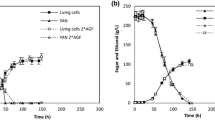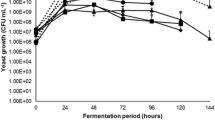Abstract
Alcoholic fermentation by an oenological strain of Torulaspora delbrueckii in association with an oenological strain of Saccharomyces cerevisiae was studied in mixed and sequential cultures. Experiments were performed in a synthetic grape must medium in a membrane bioreactor, a special tool designed to study indirect interactions between microorganisms. Results showed that the S. cerevisiae strain had a negative impact on the T. delbrueckii strain, leading to a viability decrease as soon as S. cerevisiae was inoculated. Even for high inoculation of T. delbrueckii (more than 20× S. cerevisiae) in mixed cultures, T. delbrueckii growth was inhibited. Substrate competition and cell-to-cell contact mechanism could be eliminated as explanations of the observed interaction, which was probably an inhibition by a metabolite produced by S. cerevisiae. S. cerevisiae should be inoculated 48 h after T. delbrueckii in order to ensure the growth of T. delbrueckii and consequently a decrease of volatile acidity and a higher isoamyl acetate production. In this case, in a medium with a high concentration of assimilable nitrogen (324 mg L−1), S. cerevisiae growth was not affected by T. delbrueckii. But in a sequential fermentation in a medium containing 176 mg L−1 initial assimilable nitrogen, S. cerevisiae was not able to develop because of nitrogen exhaustion by T. delbrueckii growth during the first 48 h, leading to sluggish fermentation.




Similar content being viewed by others
References
Albasi C, Tartaridis P, Taillandier P, Strehaiano P (2002) A new tool for the quantification of microbial interactions in liquid medium: application to wine lactic acid bacteria, Sc. Aliments 22:189–198
Albergaria H, Francisco D, Gori K, Arneborg N, Gírio F (2010) Saccharomyces cerevisiae CCMI 885 secretes peptides that inhibit the growth of some non-Saccharomyces wine-related strains. Appl Microbiol Biotechnol 86:965–972
Bely M, Stoeckle P, Masneuf-Pomarède I, Dubourdieu D (2008) Impact of mixed Torulaspora delbrueckii–Saccharomyces cerevisiae culture on high-sugar fermentation. Int J Food Microbiol 122:312–320
Brandam C, Lai Q, Julien-Ortiz A, Taillandier P (2013) Influence of oxygen on alcoholic fermentation by a wine strain of Torulaspora delbrueckii: kinetics and carbon mass balance. Biosci Biotechnol Biochem 77(9):1848–1853
Ciani M, Maccarelli F (1998) Oenological properties of non-Saccharomyces yeasts associated with wine-making. World J Microbiol Biotech 14:199–203
Ciani M, Pepe V (2002) The influence of pre-fermentative practices on the dominance of inoculated yeast starter under industrial conditions. J Sci Food Agric 82:573–578
Ciani M, Beco L, Comitini F (2006) Fermentation behaviour and metabolic interactions of wine yeast fermentations. Int J Food Microbiol 108:239–245
Ciani M, Comitini F, Mannazzu I, Domizio P (2010) Controlled mixed culture fermentation: a new perspective on the use of non-Saccharomyces yeasts in winemaking. FEMS Yeast Res 10:123–133
Escudero A, Gogorza B, Melus MA, Ortin N, Cacho J, Ferreira V (2004) Characterization of the aroma of a wine from Maccabeo. Key role played by compounds with low odor activity values. J Agric Food Chem 52:3516–3524
Farkas G, Rezessy-Szabo JM, Zakany F, Hoschke A (2005) Interaction of Saccharomyces and non-Saccharomyces yeast strains in an alcoholic fermentation process. Acta Aliment 34:81–90
Fleet GH, Heard GM (1993) Yeasts—growth during fermentation. In: Fleet GH (ed) Wine microbiology and biotechnology. Harwood Academic Publishers, Chur, p 27
Hansen EH, Nissen P, Sommer P, Nielsen JC, Arneborg N (2001) The effect of oxygen on the survival of non-Saccharomyces yeasts during mixed culture fermentations of grape juice with Saccharomyces cerevisiae. J Appl Microbiol 91:541–547
Herraiz T, Reglero G, Herraiz M, Martin-Alvarez PJ, Cabezudo MD (1990) The influence of the yeast and type of culture on the volatile composition of wines fermented without sulfur dioxide. Am J Enol Vitic 41:313–318
Jackson R (1994) Chemical constituents of grapes and wine. In: Taylor SL (ed) Wine science. Principles and applications. Academic Press, San Diego, p 178
Jacobs CJ, Van Vuuren HJ (1991) Effect of different killer yeasts on wines fermentation. Am J Enol Vitic 42:295–300
Lema C, Garcia-Jares I, Angulo L (1996) Contribution of Saccharomyces and non-Saccharomyces populations to the production of some components of Albarino wine aroma. Am J Enol Vitic 47:206–216
Mauricio JC, Moreno J, Valero EM, Zea L, Medina M, Ortega JM (1998) Infuence of oxygen on the biosynthesis of cellular fatty acids, sterols and phospholipids during alcoholic fermentation by Saccharomyces cerevisiae and Torulaspora delbrueckii. World J Microbiol Biotech 14:405–410
Miller GL (1959) Use of DNS acid reagent for determination of reducing sugars. Anal Chem 31:426–428
Moreira N, Mendes F, Guedes de Pinho P, Hogg T, Vasconcelos I (2008) Heavy sulphur compounds, higher alcohols and esters production profile of Hanseniaspora uvarum and Hanseniaspora guilliermondii grown as pure and mixed cultures in grape must. Int J Food Microbiol 124:231–238
Moreno JJ, Millán C, Ortega JM, Medina M (1991) Analytical differentiation of wine fermentations using pure and mixed yeast cultures. J Ind Microbiol Biotech 7:181–189
Nissen P, Nielsen D, Arneborg N (2003) Viable Saccharomyces cerevisiae cells at high concentrations cause early growth arrest of non-Saccharomyces yeasts in mixed cultures by a cell–cell contact-mediated mechanism. Yeast 20:331–341
Ocón E, Gutiérrez AR, Garijo P, Tenorio C, López I, López R, Santamaría P (2010) Quantitative and qualitative analysis of non-Saccharomyces yeasts in spontaneous alcoholic fermentations. Eur Food Res Technol 230:885–891
Pérez NF, Albergaria H, Hogg T, Girio F (2006) Cellular death of two non-Saccharomyces wine-related yeasts during mixed fermentations with Saccharomyces cerevisiae. Int J Food Microbiol 1:336–345
Pillet O, Aguera E, Silvano A, Languet P (2010) Ensemencement séquentiel d’une levure non-Saccharomyces et d’une levure Saccharomyces cerevisiae, Vers de nouveaux horizons aromatiques. Revue des Œnologues 135:13–18
Rapp A, Pretorius P, Kugler D (1992) Foreign an undesirable flavours in wine. Dev Food Sci 28:485–522
Renault P, Miot-Sertier C, Marullo P, Hernández-Orte P, Lagarrigue L, Lonvaud-Funel A, Bely M (2009) Genetic characterization and phenotypic variability in Torulaspora delbrueckii species: potential applications in the wine industry. Int J Food Microbiol 134:201–210
Renouf V, Falcou M, Miot-Sertier C, Perello MC, De Revel G, Lonvaud-Funel A (2006) Interactions between Brettanomyces bruxellensis and other yeast species during the initial stages of winemaking. J Appl Microbiol 100:1208–1219
Rojas V, José Gil V, Piñaga F, Manzanares P (2001) Studies on acetate ester production by non-Saccharomyces wine yeasts. Int J Food Microbiol 70:283–289
Salgado ME, Albasi C, Riba JP (2000) A two-reservoir, hollow-fiber bioreactor for the study of mixed-population dynamics: design aspects and validation of the approach. Biotechnol Bioeng 69:401–408
Xufre A, Albergaria H, Inácio J, Spencer MI, Gírio F (2006) Application of fluorescence in situ hybridisation (FISH) to the analysis of yeast population dynamics in winery and laboratory grape must fermentations. Int J Food Microbiol 108:376–384
Zagorc T, Maráz A, Cadez N, Povhe JK, Péter G, Resnik M, Nemani J, Raspor P (2001) Indigenous wine killer yeasts and their application as a starter culture in wine fermentation. Food Microbiol 18:441–451
Acknowledgments
We would like to thank the Vietnamese and French Governments for providing the grant and Lallemand S.A.S., France for providing the yeast strains.
Author information
Authors and Affiliations
Corresponding author
Rights and permissions
About this article
Cite this article
Taillandier, P., Lai, Q.P., Julien-Ortiz, A. et al. Interactions between Torulaspora delbrueckii and Saccharomyces cerevisiae in wine fermentation: influence of inoculation and nitrogen content. World J Microbiol Biotechnol 30, 1959–1967 (2014). https://doi.org/10.1007/s11274-014-1618-z
Received:
Accepted:
Published:
Issue Date:
DOI: https://doi.org/10.1007/s11274-014-1618-z




